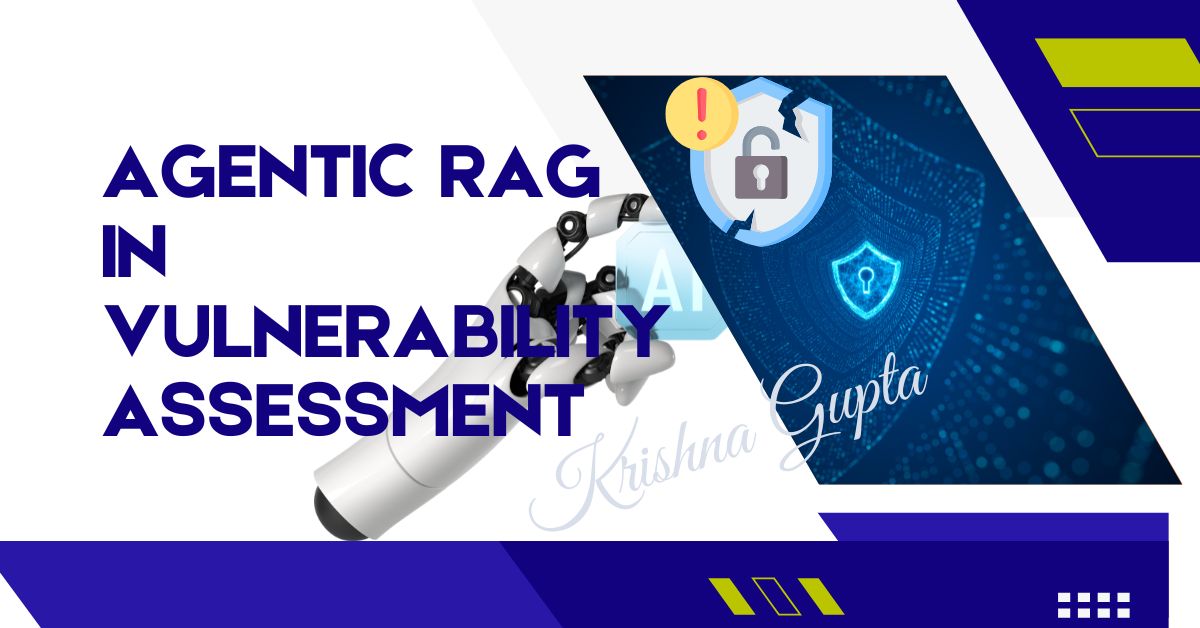Agentic RAG in Vulnerability Assessment and Vulnerability Management
Purpose: To explore how Agentic Retrieval-Augmented Generation (RAG) revolutionises vulnerability assessment and management through autonomous decision-making, context-aware retrieval, and intelligent automation — with a strong focus on ROI, business impact, and proactive risk mitigation.
1. Executive Summary
C-Suite leaders often ask: How do we proactively detect vulnerabilities before they’re exploited?
The answer lies in Agentic Retrieval-Augmented Generation (RAG) — a dynamic AI architecture that merges LLMs with context-rich databases and autonomous agent workflows. Agentic RAG doesn’t just identify known CVEs; it intelligently predicts emerging threats, automates triage, and generates context-aware remediation blueprints.
When deployed within Vulnerability Assessment (VA) and Vulnerability Management (VM) pipelines, Agentic RAG shifts cybersecurity from reactive to proactive, reducing time to mitigation and enabling real-time risk governance.
2. Introduction to Agentic RAG
What is Agentic RAG?
Agentic RAG is the evolution of traditional RAG — where LLMs retrieve contextual knowledge and autonomously act on it. In an agentic model:
- Multiple agents collaborate across a task.
- Each agent has a purpose (retrieval, validation, remediation).
- The system makes decisions, explains them, and adapts in real time.
Core Components:
- LLM (e.g., GPT-4, Claude): For interpreting scan results and generating recommendations.
- Retrievers: Access structured/unstructured data (threat intel, CVEs, logs).
- Agentic Orchestrator: Chooses the next best action.
- Feedback Loop: Continuously improves performance.
3. Vulnerability Assessment and Management: A Primer
Vulnerability Assessment (VA):
A point-in-time snapshot of known security weaknesses via:
- Automated Scanners (Qualys, Nessus, OpenVAS)
- Manual validation
- Reporting of CVEs
Vulnerability Management (VM):
An ongoing process that includes:
- Prioritisation (CVSS, asset sensitivity)
- Patch/Remediation tracking
- Verification
- Governance and reporting
Traditional Challenges:
- Delayed patch cycles
- Static prioritisation
- Human error in triage
- Inability to track zero-days
4. The Evolution: From Static Scanning to Agentic Intelligence
| Feature | Traditional VA/VM | Agentic RAG-Enhanced VA/VM |
| Threat Identification | Based on signatures | Combines known, unknown, and predictive risks |
| Prioritisation | CVSS + manual input | Contextual (business impact, threat intel, exploitability) |
| Remediation | Static playbooks | Dynamic, auto-generated workflows |
| Insights | PDF Reports | Interactive, conversational, evolving |
| Actionability | Human-driven | AI agent-driven, self-adaptive |
5. Architecture of Agentic RAG in VA/VM
Agentic RAG Workflow in VA/VM:
[Asset Inventory] → [VA Scanner] → [Agentic RAG Engine]
↓
[Retriever Agent] + [Risk Prioritisation Agent]
↓
[Remediation Agent] → [Report Agent] → [Dashboard/API]
Key Technologies:
- Vector Databases (e.g., Pinecone, FAISS): For rapid context retrieval
- Knowledge Graphs: Relationship mapping (asset ↔ CVE ↔ threat group)
- Agent Frameworks: LangChain, AutoGen, CrewAI
6. Use Cases Across the Cybersecurity Lifecycle
1. Continuous Risk Scoring:
Agentic RAG recalculates risk scores based on:
- Current exploitability
- Business criticality of asset
- MITRE ATT&CK relevance
2. Predictive Threat Mapping:
Agent retrieves TTPs from threat intel feeds and maps them to current vulnerabilities.
3. Auto-Triage and Escalation:
Autonomous agents flag risks needing immediate attention and assign them to SOC teams.
4. Patch Management Recommendations:
Agent recommends vendor-specific patches or config-based mitigations based on environment.
5. Executive Briefings:
Summarised risk posture reports for CEOs and boardrooms, updated in natural language daily.
7. ROI and Business Impact for the Enterprise
1. Reduced Time-to-Patch
⏱ Up to 40% reduction in patch deployment delays through AI-automated workflows.
2. Enhanced Risk Mitigation
🎯 Prioritisation accuracy increased by 60%, reducing false positives and alert fatigue.
3. Cost Optimisation
💰 Savings of up to $250K/year in mid-sized organisations by replacing fragmented tools and manual labour.
4. Real-Time Governance
📊 Dynamic dashboards and agent-generated regulatory reports (e.g., ISO, GDPR, PCI-DSS).
8. Challenges and Mitigations
| Challenge | Agentic RAG Mitigation |
| Hallucinations | Use retrieval-anchored agents with audit trails |
| Bias in prioritisation | Inject business logic and external threat feeds |
| Data privacy | On-prem deployment with role-based access |
| Toolchain integration | Use APIs and agent plug-ins for existing SIEMs/VMs |
9. Future Trends
- Self-Healing VA Pipelines: Agents not only detect but initiate patch orchestration.
- Zero-Day Awareness Agents: Cross-source retrieval from GitHub, Twitter, and dark web forums.
- CTEM Alignment: Agentic RAG becomes the core of Continuous Threat Exposure Management (CTEM).
10. Final Thooughts
C-Suite executives are no longer asking if AI should be integrated into cybersecurity — they’re asking how fast. Agentic RAG in Vulnerability Assessment and Management represents a monumental leap in how organisations understand and address cyber risk. By turning passive scans into intelligent actions, companies shift from defence to offence — from reaction to anticipation.
The result?
→ Faster response.
→ Lower cost.
→ Greater peace of mind.
Agentic RAG is not the future of vulnerability management — it’s already reshaping the present.
11. Executive Checklist
| ✅ | Governance Area |
| ☐ | Have we implemented AI agents in our VA/VM stack? |
| ☐ | Are vulnerability risks prioritised by business impact and exploitability? |
| ☐ | Do our dashboards update dynamically with RAG insights? |
| ☐ | Is agent output traceable and compliant with audit requirements? |
| ☐ | Are patch cycles automated and tracked via autonomous workflows? |
